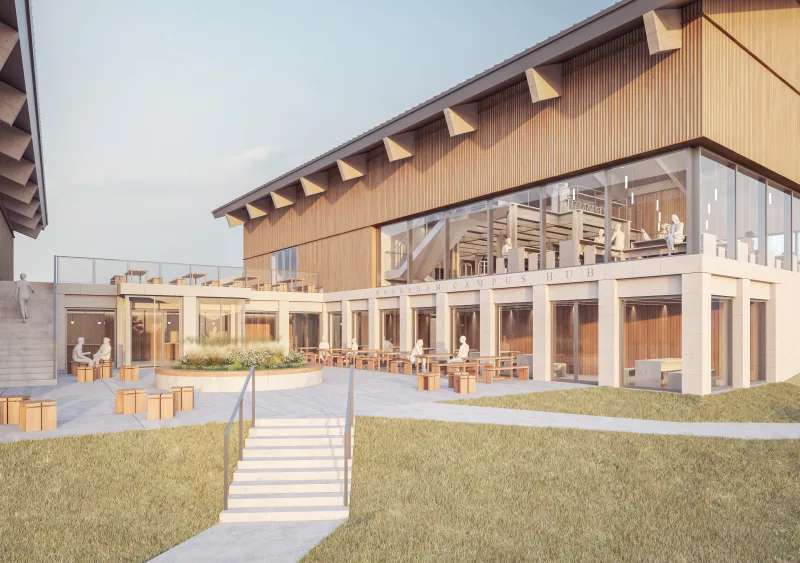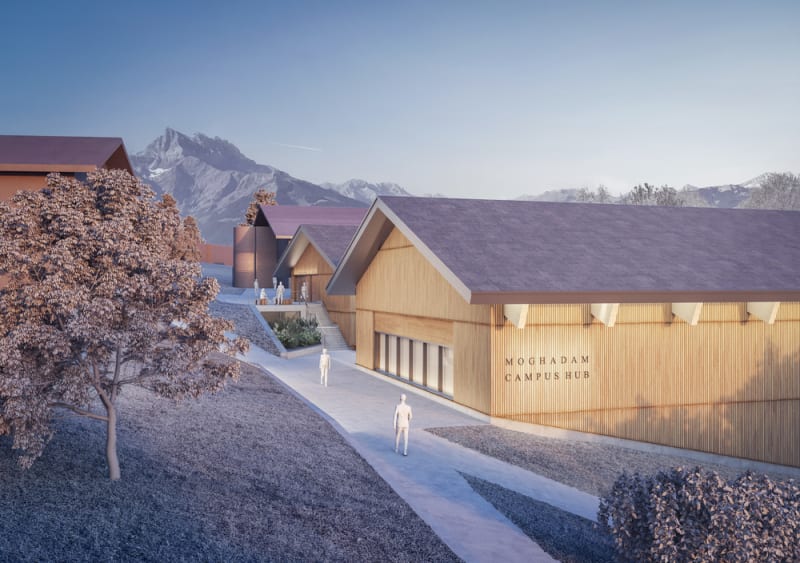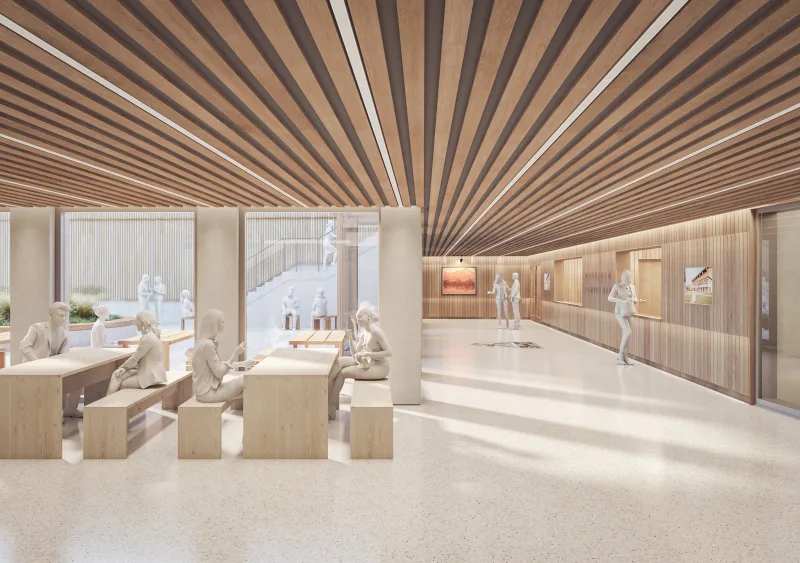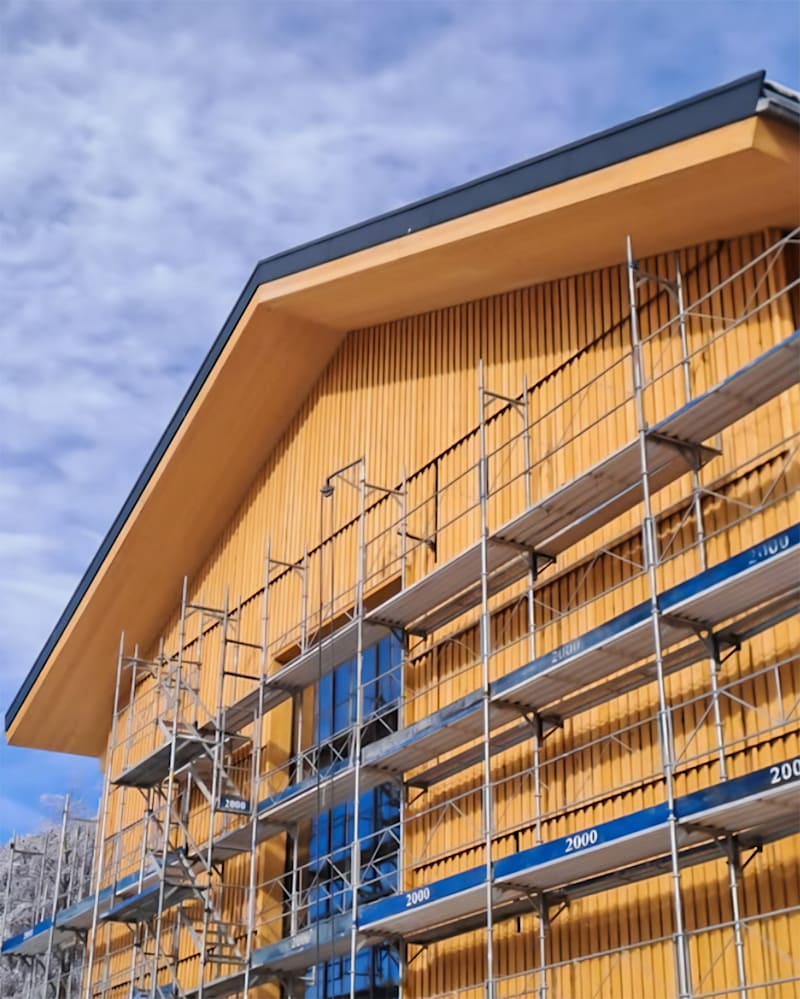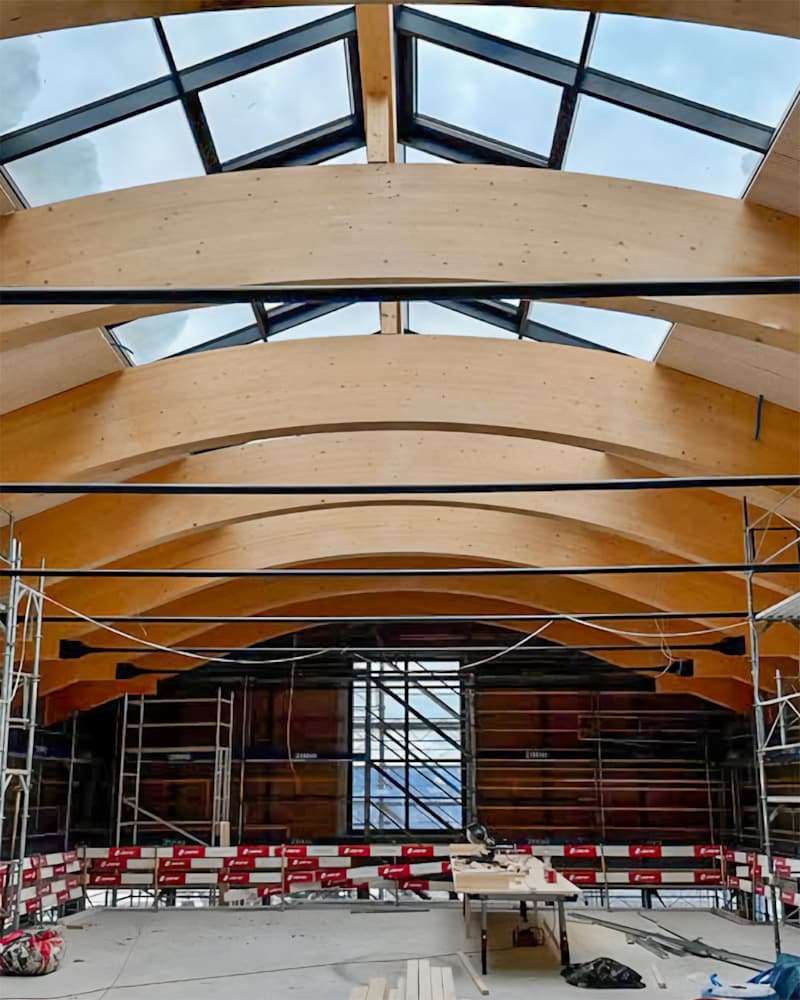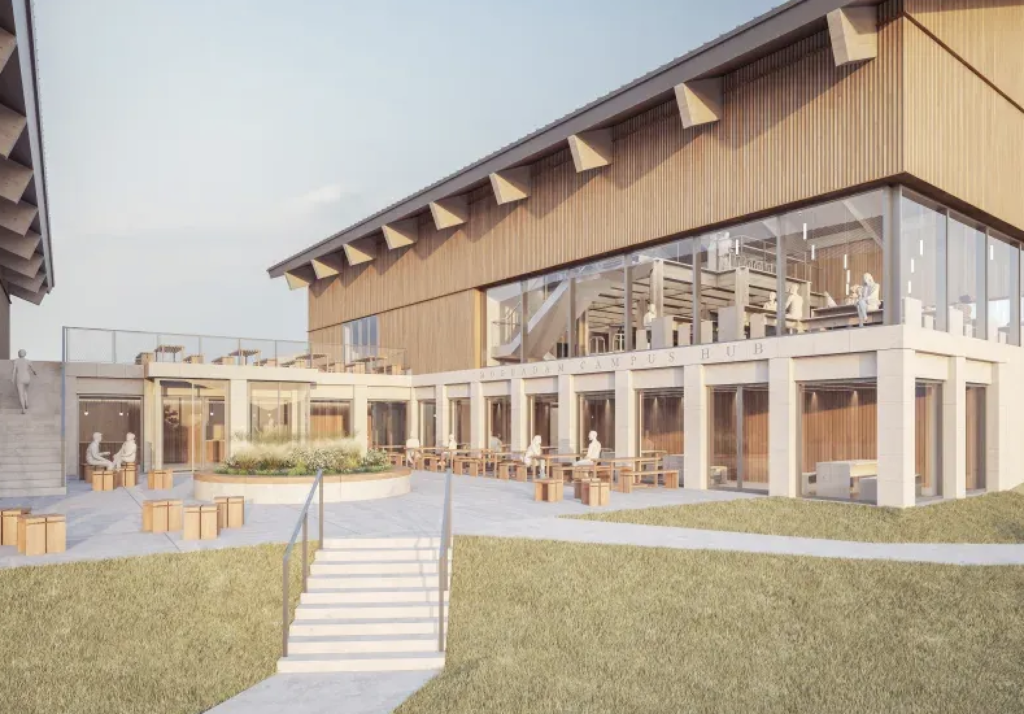Aiglon College’s Moghadam Campus Hub officially opens in August. The new performing arts and dining space represents the most ambitious building project in the school’s 76 year history.
The building stands ready to transform the daily life of students and staff in a way that few previous projects could have imagined. By creating new spaces both for Meditation (the school’s daily, reflective assembly) and dining facilities, the building is set to become the heart of community life.
Reflecting Our Heritage, Embracing the Future
While both the school and global Aiglon community prepare for the grand opening, a dedicated team of architects and project managers have been working since the project’s conception to ensure this space could be realised in a manner that represents the school’s strategic ambitions, respects its traditions and exemplifies the best of contemporary sustainability standards, all while also blending in with the campus and village alpine setting.
However, combining that ambition with the practicalities of a mountain-side construction project in the midst of an already busy campus is no small feat. The building has been designed by Clews Architects, a UK firm who have collaborated with Aiglon since 2011 on the development of the school’s strategic campus masterplan, and this is the first building that the firm has also designed for the school. Responsible for delivering the project is Swiss firm, CP3 Architecture, who have the needed local expertise to meet precise local standards and optimise energy efficiency. Finally, David Flight of Capital Partners has managed the project on behalf of the school from pre-planning through to delivery.
Andy Croft, Aiglon’s Director of Operations highlighted the strategic and values-driven approach these teams had to deliver. “It’s been vital since the school’s founding that the community comes together regularly,” says Andy. “As the school has grown and changed over time, this building will allow us to gather in the way we want to do it now while still maintaining the tradition we had before.” He recalls bringing the architects to experience Meditation right at the beginning and saying, “The building’s primary function is to make sure we can do this forever.”
Part of the Village
Mark Smith, Managing Director at Clews, highlights the key role the building needed to play in the wider landscape. “From our knowledge developing the masterplan, we knew there were very few new build development sites for the school. So it was really important that whatever we did on this site, we did it well and in a sustainable way.” Alex Stevens, design architect at Clews, highlights the decision to split the building into two, but to share a common plinth. “By developing a multi-pitched structure, the two parts of the building don’t need to fight each other, but can do what they need to do and fit comfortably in the setting of a mountainside next to the existing buildings.” This type of split design is reflected in other examples of Aiglon’s more recent constructions such as the Belvedere and Exeter boarding houses.
The site itself was another driving force behind the project’s design. As a key location within the school’s strategic campus masterplan, it was one of the last significant sites that would not require the demolition of existing structures. This meant that whatever was created here needed to be exemplary—not only in terms of its function but also in how it responded to its surroundings. “We wanted the building to feel in harmony with its setting,” Alex says. “But at the same time, this project needed to be a focal point, a sign of things to come for the school.”
The theatre will have a maximum capacity of 420 seats. This is the largest the theatre could be given the mountainside space, and yet it is able to work at a capacity that will support the school’s ongoing regular and daily use. Special events like graduation will still take place in the nearby Tony Jashanmal Sports Centre. Balancing the building’s scale with its usability is reflective of the process that has been at the heart of the entire project.
Part of this challenge has been working to ensure that the new structures felt as though they belonged in the village, rather than imposing themselves upon it. The result is a design that embraces both traditional materials and contemporary detailing, drawing from local styles of chalets and barns to help blend into the landscape. “One of the things we’re most proud of is that this building, despite its scale, really settles into its environment,” says Mark. “We were very conscious that Aiglon is part of a wider community, and this design had to respect that.” The success of this approach is evident in the fact that the project encountered no opposition during the planning process—an uncommon outcome for developments of this scale.
Sustainable & Practical
Sustainability was another guiding principle, with the project team working to integrate the highest standards of environmental responsibility into every aspect of the design. The building is constructed to Minergie standards, ensuring maximum energy efficiency through high-performance insulation, airtight construction, and the use of locally sourced materials. Céline Martin of CP3 Architecture reinforces this significance. “Minergie buildings are distinguished by their systematic use of renewable energies and the exploitation of solar energy potential. They emit no CO2 during the operation and minimise emissions during construction.”
She highlights that thanks to a new regulation in Switzerland the energy generated through the building’s solar panel roof can be used for any building in the same municipality, via the public grid. “This will enable a building at the other end of the campus to benefit from this energy, for example during the school holidays when the Moghadam Campus Hub is less used. The building will therefore play a key role in reducing Aiglon’s overall energy consumption.”
David Flight highlighted that one of the most important aspects of sustainable building is reducing the use of concrete. However, it is complex to commit to a wooden structure while trying to maximise the acoustics. “We wanted the superstructure to use as much wood as possible, but that was in direct contrast to the acoustician, who wanted as much concrete as possible, because it adds sound-dampening mass.” The challenge was to find a solution that allowed us to maintain the wood structure and cladding, but also obtain the acoustics that we needed.
The building is powered by a wood pellet heating system using locally sourced wood, which aligns with Swiss renewable energy standards. Additionally, the heating infrastructure has been designed to accommodate future expansion, allowing it to provide heat to neighbouring buildings. This district heating approach is a long-term investment that will not only reduce costs for future developments but also minimise the environmental impact of each new phase of the school’s growth.
Mark, however, is quick to give these technical features some social context. “When people think about sustainability, they obviously talk about energy efficiency, but sustainability is also about people enjoying using a building,” he highlights. “If you don’t use it, if the building does not function as it should, then something else gets built elsewhere. I’ve seen it many times at schools –so it’s really important that the building works, and that once it’s opened people enjoy using it. This is a relly key part of sustainability.”
A Generous Space
Despite these ambitious measures, the team was careful to ensure that performance did not have to compromise the building’s values and ethos. Natural light is prioritised throughout the building, with large windows maximising daylight and panoramic views of the mountains. The theatre and meditation space, in particular, feature a striking south-facing window, designed to open up at the conclusion of Meditation—a symbolic moment that reconnects the community with their sense of place. “That window was something we held onto from the very beginning,” Alex says. “It’s a reminder of where you are in the world—something that’s integral to Aiglon’s identity.”
The significance of the Moghadam Campus Hub extends beyond its physical structure or sustainability credentials. At its heart, this project is about community. From the outset, the design was driven by the school’s deep-rooted tradition of gathering together—whether for Meditation, meals, or events. “This campus is so spread out that we didn’t naturally have a space where everyone could come together,” says Andy. “This building changes that.” The inclusion of flexible, open-plan areas within the school restaurant, as well as dedicated breakout spaces, means that the building is not just functional—it is generous. It provides room for students and staff to gather, interact, and reflect in a way that aligns with the school’s ethos.
This sense of generosity extends to the building’s outdoor spaces as well. The courtyard will be defined by a tremendous eagle sculpture, cast in bronze, and designed by alumnus Calyxte Campe (Alpina, 1991). The surrounding courtyards and landscaped areas between and around the buildings offer new opportunities for gathering, whether for informal meetings, passing through the campus, or a quiet moment.
In designing these spaces, the team was careful to preserve the site’s historical character, including the replanting of fruit trees in recognition of the orchard that once stood there. “We didn’t just want to build on this site,” says Alex. “We wanted to give something back to it.”
We look forward to opening this inspirational building to our community this year!
In November, LAS hosted a Model United Nations (MUN) conference that brought together over 60 students from seven schools across Switzerland. The event showcased student diplomacy and global awareness and allowed four committees to explore interesting international issues. Our students had a fantastic time gaining new knowledge and networking with fellow delegates from other schools. At LAS, we encourage our students to develop into global citizens, and events like these allow them to improve their confidence, research, and networking skills.
The conference hosted participants from other international schools, including Ecolint, Brillantmont, and Haut-Lac, creating a platform for young diplomats to engage in fascinating discussions about issues that people face around the world today. Students participated in three General Assembly committees and the UN Security Council, tackling complex global challenges.
The conference explored diverse and challenging topics, including:
- Countering Extremist Ideologies in Sub-Saharan Africa
- Juvenile Detention and Children’s Rights
- Commercialization of Outer Space
- Decolonization: The Conflict in Cyprus
Akos ‘25, who was chair of the UN Security Council, highlighted the depth of discussions surrounding their topic, Countering Extremist Ideologies in Sub-Saharan Africa. With 15 countries represented, the committee navigated complex geopolitical discussions. “The debate was very exciting,” Akos said, “and we managed to control the flow and eventually pass one of our resolutions.”
Sara ‘26, who was co-chairing the General Assembly 3 committee, focused on the topic of Juvenile Detention and Children’s Rights. Despite being a beginner committee with many first-time MUN participants, Sara was impressed by the level of engagement. “Everyone was very proactive in participating in debates that were both respectful and nuanced.”
The LAS Model UN conference was an invaluable experience for our students, offering them the opportunity to develop their diplomacy and debating skills. We are so proud of how they represented the school, and we look forward to seeing them apply and develop these skills in future conferences!
